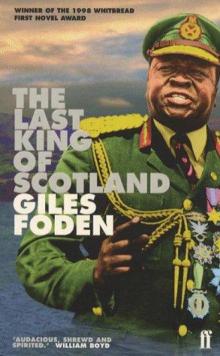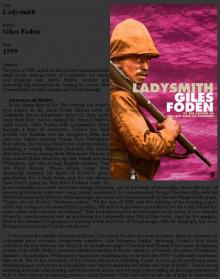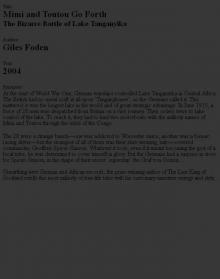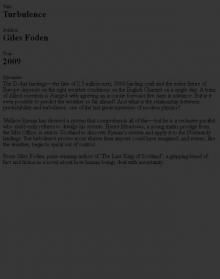- Home
- Giles Foden
2004 - Mimi and Toutou Go Forth Page 21
2004 - Mimi and Toutou Go Forth Read online
Page 21
The crew lived on the Lugard when it got to Lake Albert, and it also played the Konigin Luise in the film. The exact details of which ship performed this role have always been something of a mystery, despite The African Queen being one of the most studied location shoots ever (along with Apocalypse Now and Fitzcarraldo, for not unrelated reasons). According to an interview with the still photographer on the shoot, Arthur Lemon: ‘We lived on an old paddle-steamer called the Lugard II which had been art directed to look like a German gunboat—the one that eventually gets blown up in the film.’
The kungu seem to have put in an appearance, too.
As Lemon explained in an interview for Better Photography magazine: ‘Each evening, as the sun went down, lake flies would hatch out and swarm everywhere. Everything on the boat had to be shut up tight. They only survived thirty minutes or so and then died and fell back onto the surface of the water. Great for the Nile perch who would swim along like vacuum cleaners and scoop them up for dinner. Some of these fish were huge.’↓
≡ There is one moment in the film when Bogart is enveloped by a swarm of insects, but these seem to be mosquitoes rather than su.
Dinner was not something the cast thought much of while living on the Lugard. Everyone save Bogart and Huston (who both ‘came to the table well fortified’, according to Hepburn) went down with amoebic dysentery and diarrhoea. It was discovered that the boat’s water-filters weren’t functioning properly. There was always a queue for the toilet, where the runs turned out not to be the only problem, as Huston recalls:
One day Kevin McClory [the film’s boom boy, later a Hollywood producer] came out of it headlong with his pants down his ankles, shouting ‘Black mamba! Black mamba!’ He had been sitting there when he looked up and saw a black cylinder moving above his head. The black mamba is one of the few really aggressive snakes around, and quite deadly. We all got a glimpse of it as it slid down out of the toilet into the elephant grass…From that moment all symptoms of diarrhoea in camp disappeared.
A large motor boat called the Murchison ferried the cast and crew around during this period and was also used to transport supplies between the filming location and the village of Butiaba. The Murchison had another moment of fame three years later when it was waved down by Ernest Hemingway after his plane crashed during an African safari. The pilot had clipped a telegraph wire after swerving to avoid a flock of sacred ibis.↓
≡ The Murchison was chartered by a Scottish surgeon called Ian McAdam (later Sir Ian McAdam) who, after training a generation of East African doctors, was expelled from Uganda by Idi Amin in 1972. McAdam picked up Hemingway and his wife and took them to Butiaba—where they caught another bush plane and promptly crashed again. Hemingway, who ruptured his liver and one of his kidneys and suffered paralysis of the sphincter muscle as a result of the second crash, was reported worldwide as having died. He was a great admirer of the author of The African Queen (‘I recommend Forester…’).
It wasn’t the only vessel to have a curious afterlife: the boat that played the role of the African Queen is now berthed outside the Holiday Inn, Key Largo, Florida, as a tourist attraction. But the strangest survival of all was one much more intimately connected with Spicer-Simson’s quest to be a hero…
TWENTY-FOUR
Deo Gratias stood on the deck of the Liemba, his prisoners at his feet. I leaned on the rail, studiously casual. Nobody spoke. I was trying to ignore the handcuffed men and the way they were kneeling and shivering. We were in the tropics, it was hot, but they were huddling together. It was fear, of course, that permanent trembling motion, and the deep furrows in their brows were marks of dread.
I had fallen silent wondering why these heavily scored lines in the men’s foreheads were more disturbing to me than the more obvious knife-gash across the throat of the one with tufty hair and up-staring eyes. The edges of his wound had been sewn together with spiky stitches—recently and roughly, too, by the look of it.
The engine churned as the slow grey surface of Lake Tanganyika rolled beneath us. We could still see the Tanzanian shore, but the Congolese side to the west was lost in a haze of mist. Finally I asked Deo Gratias what crimes were most commonly committed on the Liemba. Mainly stealing, he told me, lisping like a schoolgirl.
‘And lape, ‘ he added, grinning now, spittle flying excitedly from his lips. ‘You know lape’? It is when you go inside.’
He made a sign with his hand, sighing gleefully.
His full name was Deo Gratias Webiro. He was 27. Wearing a red baseball cap and a linen suit and carrying a leather satchel, he was employed by the Tanzanian Ministry of the Interior. He was to be distinguished from the khaki-clad askaris on board. They were just ordinary policemen. Uneducated men, as he described them to me. Uneducated men, I wrote in my notebook.
Deo Gratias’s two charges were crouched with their backs against a capstan. One was grizzled and had a stricken expression that reminded me of sinners in Renaissance paintings. The other one—with the sewn-up throat—was wild-haired, trampish, like a reggae star fallen on hard times.
Deo Gratias pointed to him. ‘This one, he keeps trying to cut his own throat.’ Then he pointed at the grizzled sinner: ‘He murdered a friend, beating him with sticks. This one will be hanged, I think.’
Nearby, a man in a skullcap had unrolled his that and begun to pray. Above him I spotted some graffiti written in black felt-tip on the ship’s white paintwork. The Swahili words read Wapi Mama Shakira? (‘Where’s Mama Shakira?’), apparently a reference to the Liemba’s, most famous prostitute, now dead. Also scrawled on the wall were the words Good Lucky Kajembe and, in a different hand, Al Qaeda.
A woman in a print dress, her breasts heaving, rushed up to tell us that someone had started brawling in the hold. Deo Gratias went off to investigate, his satchel bobbing on his thigh. Now he was gone I slipped the murderer a bottle of mineral water, setting it down on the steel deck by his uncuffed hand. Brand name: Maji Poa. Good water, pure water. He did not acknowledge me, but simply stared out across the forbidding grey waves of Lake Tanganyika.
The date was 13 August 2003.1 had boarded the ship at Kigoma, the port town that had been captured from the Germans by the Belgians 87 years earlier. The Liemba was a cargo-and-passenger ship that every week made its way up and down the lake—when it eventually got going. The loading of the vessel was a chaotic business that lasted the best part of three hours. But eventually, once the interminable sacks of dried fish and the pinch-beaked chickens, the cobs of maize in their bright green sheaths and the heavy pineapples had all been stowed away, once the fog-horn had sounded and the sinewy stevedores cleared the gangplank—and the gangplank itself had been lifted on board by the ship’s crane—we got under way.
My principal purpose in making the journey was to investigate the bizarre naval episode that had wrested the lake from German control, and to find out what legacy—if any—those tumultuous events at the far edges of the Great War had in the memory of local people. One of these memories I knew about, because it took physical form. The Liemba had been a German warship in a previous incarnation. I was standing on the Graf von Götzen.
Astonishing as it may seem, Spicer’s nemesis is still afloat.
§
By the time I emerged from my cabin, night had fallen. Having an appointment with the captain, I followed the maze of pipework and narrow corridors that made up the Liemba’s double-deck structure. The whole place stank. People were lying about everywhere on mattresses, amid piles of fruit and the long white sacks of dagaa (dried fish), which were the ship’s main cargo. Many of the passengers had yellow plastic jerrycans of water and thin steel mess-tins. A large proportion of the travellers were refugees from wars in Congo and Burundi, hoping for a better life in Zambia, the ship’s destination at the southern end of the lake.
The gangway was tight. One woman, sad-faced and cuddling her ten-year-old daughter, asked me in French for money as I squeezed by. ‘Voudriez vous, monsieur, nous faire une c
ontribution matérielle?’
I gave her five US dollars.
‘C’est rien, ‘ she said. Then, to my amazement, she handed it straight back.
The bridge, as I entered it—after asking permission of the bearded crewman on guard outside—was a place of almost total darkness. A radar screen showed the ship’s course as a straight green line; its glow was more or less the only light in the room. A mass of soft curves on his stool, the moon-faced captain had no desire to talk about the past. He was looking ahead into the night—watching for whalers, watching for canoes.
‘It is all written down in the books,’ he said slowly, but with some irritation.
As he spoke, one hand gripped and ungripped the polished wood of the wheel. The wheel itself seemed rigid, fixed. It must be on autopilot, I thought, imagining some kind of clamp down below.
‘This is the ship of history,’ the captain said. ‘It is well known.’
He glanced down at the radar.
‘No,’ I insisted. ‘Only the white man’s side of the Liemba story is written down. Not your side.’
He looked at me, perplexed, then shook his head.
I peered through the gloom at the other instruments, oddly illuminated by the radar’s spectral light. The captain moved his hand slightly and the wheel moved accordingly. No autopilot.
Back in my cabin, I scolded myself for expecting that anyone should be interested in the tale. The African askaris and carriers who had fought in the War had suffered great privations on behalf of the belligerent colonists; but that didn’t mean their descendants were obliged to remember it all. Certainly, I thought as I went to bed, they could not be expected to do so to satisfy my craving for more detail.
§
Tanzania’s national museum is a poor place, down at heel and badly lit. I visited it before leaving for Lake Tanganyika. Walking through the section called ‘Africa’, I found myself looking at a display of amulets. One was a small piece of lion skin (about the size of an envelope), upon which were written some protective Arab verses. Near to it was a statue of the kind anthropologists call a fetish object. A rough, red-clay model of a human figure holding outsize goggles to its eyes, it stood about two feet high. Not goggles, binoculars. I studied the fingermarks in the clay. Beneath the exhibit was some writing on a card in Swahili: Wazungu wanaweza kuona mbali kuliko watu mngire (‘The European can see beyond the range of other people’). The fundisho or moral was also explained: ‘Beware of Europeans, they put glasses in their eyes and can see a person on the hill opposite.’ The only hill opposite right then was a plaster of Paris model of Tanzania’s geological strata, stretching down through time. I experienced a bizarre feeling of tumbling as I recalled a native fetish made by the Holo-holo in 1915. Like this one, it had a large head and was kneeling. Like this one, the figure grasped a pair of binoculars in its tiny hands. It also had small incisions on its chest and forearms. They marked the tattoos on the body of the man in whose tracks I had come: Commander Geoffrey Basil Spicer-Simson, RN.
Navyman God, as Dr Hanschell’s servant Rupia had called him. Lord Bellycloth, as he was known to his Holo-holo followers. Bwana Chifunga-Tumbo. A very remarkable person, in spite of his failings. Here, as they would on the Liemba, the ghosts of the past were whispering.
Another of the museum’s attractions was ‘The Hall of Man’—an echoey tunnel in which were displayed model skulls from different eras of human antiquity. These included the seminal discoveries made by Louis and Mary Leakey in Tanzania’s Olduvai Gorge in the 1960s and 1970s. I was pleased to see these ancient ancestors, but however many times I read about it or hear it explained, I always forget how the story goes. Some ape-human creature (Australopithecus?), then the tool-user (Homo habilis), then us (Homo sapiens)—is that it? And the Neanderthals a red herring, a cul-de-sac—off the main drag and possibly wiped out by our ancestors? Was that today’s thinking? I couldn’t remember.
There were several cabinets of minerals and metals in ‘The Hall of Man’, which seemed like a category mistake, but then again not. In lumps of rock, gold pyrites glittered. Precious motes were sprinkled on the surfaces—the jagged edges, the smooth faces—like expensive pepper. Yet the lumps also seemed to shine from deep within. A geologist could tell the story of these fragments. I stared at them in the semi-darkness.
The section entitled ‘Europe in Africa’ was designed to shame the European. Railways and time-management are not the civilising benisons they were once thought to be. Among cabinets of curios and curling photographs of imperial soldiers of one sort and another, I discerned a chilling modern version of the genocide of the Neanderthals: Germany’s extermination of the Herero tribe in South West Africa in 1904 and its equally ruthless suppression of the Maji-Maji rebellion here in Tanzania.
The same Swahili word that was on the plastic bottle I’d given to the prisoner—maji, water—gave its name to this rebellion. From 1905 to 1907, the Africans of this region revolted against German rule: against hut taxes, against forced labour, against a stated policy that made them economically dependent on the white invader and his cash crop, cotton. Foreign seed was imported and planted under duress.
The word maji in this context refers to a political movement whereby a secret communication about driving out the invaders was passed from one individual to another. The secret was that a powerful medicine had been found that would make the white men vulnerable. The special water was carried about the person in small containers made from maize or millet cobs. Before battle a little would be drunk and sprinkled about the body in order to ward off bullets. Under its charm, the enemies’ rifles would spurt only water and bullets would trickle like raindrops from the Africans’ bodies.
But maji let them down. Anyone suspected of involvement in the rebellion or displaying the slightest resistance to the new agricultural schemes was hanged and a scorched-earth policy implemented.↓
≡ A technique Götzen learned from the British containment of Afrikaners during the Anglo-Boer War (1899–1902).
Close to 120,000 Africans were either executed or died from the famine that followed. It wasn’t just a case of black and white. While Indian traders—of whom by 1905 there were nearly 7,000 in Tanganyika—were accused by the Germans of fomenting the rebellion, a number of Papuan and Melanesian troops were drafted from German possessions in the Pacific to help put it down.
The man responsible for the ‘mild administrative pressure’ (as he called it) that sparked a rebellion—and the bloody counter-measures that suppressed it—was Count von Götzen, military governor of German East Africa from 1901 to 1906. The ship I would travel in had once been named in this man’s honour.
I stared at the exhibit: a large Iron Cross flag and a ship’s wheel. It was the original wheel of the Graf von Götzen. A sign told me the ship had been salvaged from the bottom of Lake Tanganyika by the Belgians after the War, but it said nothing about what had happened to her before or since.
§
On the Liemba⁄Götzen, after a few beers in the bar and a plastic dish of beef and rice, I had fallen asleep with stories of Hutu bandits in my head. There had been recent threats that they would attack the ship, but I hadn’t given them much credence. So when the screams awoke me, I thought that was it. Finally, years of travel in Africa had caught up with me; this time I was for the chop, in a place where the machete was the weapon of choice.
Out of the night came a ritualised screaming, a caterwauling woman’s voice. ‘Pata rowe! Pata rowe! Pata rowe kwa samaki!’
I stirred uneasily on the leather couchette which, when I’d come in, had been slick with the sweat of others. Now it was wet with mine.
Someone banged on the door. ‘Katlesi ya samaki!’
It was Swahili, but I couldn’t catch their meaning. ‘Pata rom!Pata rower Then, tailing off, ‘Katlesi…’
It wasn’t just one woman, I soon realised. Numerous voices were shouting all over the ship. The noise even drowned out the dull thud-thud of the engines. I gl
anced at my watch. It was about one in the morning. Slowly I became aware of something else: the ship had stopped and the engines were just idling. There were more shouts. I went to the window to see what was happening, but all I could see were dark shapes and the occasional nicker of light. There was nothing for it. I would have to go out.
I unlocked the door and turned the handle. The door wouldn’t budge. I had to push hard—into a flowing mass of people—to get out on to the walkway. I really had to put my shoulder into it, like a prop forward.
Tumbling out of the cabin, I saw that the crowd covered the decks and extended down the side of the ship. Some 200 feet long, 30 feet down, more or less the whole side of the Liemba was covered with climbing figures. Some were climbing down, some up. There was fighting on the way: punching, pulling, kicking, stamping. It wasn’t entirely selfish—there was some altruism, some handing me up and handing me down—but the atmosphere was mostly Darwinian, there was no getting away from it.
There were boys as well as women, and they were shouting too. ‘Pafa rowe! Samaki-samaki-samaki!’
Someone fell, cracking a rib on the side of a boat down below. Others ate their dinner. Groggily, I began to comprehend what was happening. We were at a fast-food station, that was all; even though it was the middle of the night, in the middle of the lake. I asked someone what Patamm kwa samaki meant. Fish with cassava-flour puddings. And Katlesi ya samaki? Fish cutlets.
Because of the threat of ambush and a lack of natural landing places, the Liemba avoids stopping close to the shore during its weekly 800-mile round trip. Instead, it halts at ‘stations’ in the middle of the lake. Boats come out from the shoreside villages to sell food, trade with passengers and enable others to embark or disembark. This is what was happening; chop was in order, but not the kind I had imagined.

 The Last King of Scotland (1998)
The Last King of Scotland (1998) Zanzibar
Zanzibar Turbulence
Turbulence The Last King of Scotland
The Last King of Scotland 1999 - Ladysmith
1999 - Ladysmith 2004 - Mimi and Toutou Go Forth
2004 - Mimi and Toutou Go Forth 2009 - Turbulence
2009 - Turbulence